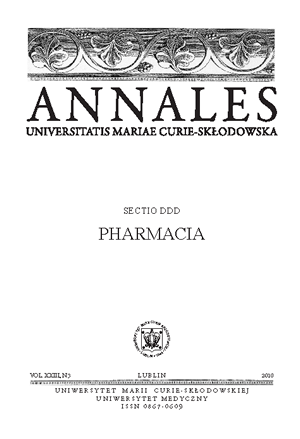Porównanie kolonizacji górnych dróg oddechowych przez Haemophilus influenzae i Staphylococcus aureus u zdrowych dzieci w wieku przedszkolnym eksponowanych i nie eksponowanych na dym tytoniowy
Słowa kluczowe:
influenzae, Staphylococcus aureus, kolonizacja górnych dróg oddechowych, bierne palenie, zdrowe dzieci przedszkolneAbstrakt
W badaniach oceniano wpływ narażenia na dym tytoniowy na kolonizację górnych dróg oddechowych przez Haemophilus influenzae oraz Staphylococcus aureus u zdrowych dzieci w wieku przedszkolnym (3-5 lat). Do badań włączono 344 dzieci, w tym 268 uczęszczających do przedszkola i 76 przebywających w domu. Do identyfikacji wyizolowanych bakterii stosowano rutynowe metody diagnostyczne. Narażenie na dym tytoniowy istotnie statystycznie zwiększyło częstość kolonizacji górnych dróg oddechowych przez H. influenzae w porównaniu z kolonizacją u dzieci bez ekspozycji, bez wpływu na częstość kolonizacji przez S. aureus. Wzrost częstości kolonizacji przez H. influenzae stwierdzono zarówno w ogólnej populacji - z 7,0% na 16,3% (p = 0,0098, RR = 2,327), jak i u dzieci przebywających w przedszkolach – z 7,1% na 17,2% (p = 0,014, RR = 2,41). Uzyskane dane sugerują, że u małych dzieci, zwłaszcza przebywających w przedszkolach, bierne palenie może być czynnikiem predysponującym do kolonizacji górnych dróg oddechowych przez H. influenzae.
Bibliografia
1. Arcavi L., Benowitz N.L.: Cigarette smoking and infection. Arch. Intern. Med., 164, 2206, 2004.
2. Coen P.G., Stuart J.M., Ashby D. et al.: Is it exposure smoke or to smokers which increases the risk of meningococcal disease in teenagers? Int. J. Epidemiol., 35, 330, 2006.
3. Durmaz R., Tekerekoglu M.S., Kalcioglu T. et al.: Nasal carriage of methicillin-resistant Staphylococcus aureus among smokers and cigarette factory workers. New Microbiol., 24, 143, 2001.
4. Greenberg D., Broides A., Blancovich I. et al.: Relative importance of nasopharyngeal versus oropharyngeal sampling for isolation of Streptococcus pneumoniae and Haemophilus influenzae from healthy and sick individuals varies with age. J. Clin. Microbiol., 42, 4604, 2004.
5. Greenberg D., Givon-Lavi N., Broides A. et al.: The contribution of smoking and exposure to tobacco smoke to Streptococcus pneumoniae and Haemophilus influenzae carriage in children and their mothers. Clin. Infect. Dis., 42, 897, 2006.
6. Gunnarson R.K., Holm S.E., Soderstrom M.: The prevalence of potentially pathogenic bacteria in nasopharyngeal samples from individuals with a long-standing cough-clinical value of a nasopharyngeal sample. Family Practice, 17, 150, 2000.
7. Iles K., Poplawski N.K., Couper R.T.L.: Passive exposure to tobacco smoke and bacterial meningitis in children. J. Pediatr. Child Health., 37, 388, 2001.
8. Moxon E.R., Wilson R.: The role of Haemophilus influenzae in the pathogenesis of pneumonia. Rev. Infect. Dis., 13, Suppl 6, 518, 1991.
9. Murphy T.F.: Otitis media, bacterial colonization and smoking parent. Clin. Infect. Dis., 42, 904, 2006.
10. Murphy T.F.: Respiratory infections caused by non-typeable Haemophilus influenzae. Curr. Opin. Infect. Dis., 16, 129, 2003.
11. Peerbooms P.G.H., Engelen M.N., Stokman D.A.J. et al.: Nasopharyngeal carriage of potential bacterial pathogens related to day care attendance, with special reference to the molecular epidemiology of Haemophilus influenzae. J. Clin. Microbiol., 40, 2832, 2002.
12. Pereiró I., Díez-Domingo J., Segarra L. et al.: Risk factors for invasive disease among children in Spain. J. Infect., 48, 320, 2004.
13. Principi N., Marchisio P., Schito G.C. et al.: Risk factors for carriage of respiratory pathogens in the nasopharynx of healthy children. Pediatr. Infect. Dis. J., 18, 517, 1999.
14. Safdar N., Maki D.G.: The commonality of risk factors for nosocomial colonization and infection with antimicrobial-resistant Staphylococcus aureus, Enterococcus, gram-negative bacilli, Clostridium difficile and Candida. Ann. Intern. Med., 136, 834, 2002.
15. Zalacain R., Sobradillo V., Amilibia J. et al.: Predisposing factors to bacterial colonization in chronic obstructive pulmonary disease. Eur. Respir. J., 13, 343, 1999.
Pobrania
Opublikowane
Numer
Dział
Licencja
Prawa autorskie (c) 2010 Autorzy

Praca jest udostępniana na licencji Creative Commons Attribution-NonCommercial-NoDerivatives 3.0 Unported License.


